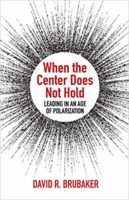Since every congregation occupies a spectrum of beliefs and values, all congregations experience conflict. Most manage their differences with grace and respect, while others—with no greater disagreements—blow apart. Why do differences tear some congregations asunder, while most manage them with relative aplomb?
Conflict-healthy congregations possess a shared sense of identity and purpose that binds the congregation together—a social glue that bonds diverse individuals. With a clear and shared identity and purpose, conflict is not a great threat. A clear sense of identity is expressed primarily through rituals (such as worship) and artifacts (such as mission and values statements). A clear sense of purpose is articulated primarily through verbal reminders from leadership of why your congregation exists and through written vision statements and goals.
Clear Identity
As with an adult individual, a clear identity is a fundamental requirement for a healthy congregation. As Richard Rohr says in Falling Upward, “When you get your ‘Who am I?’ question right, all the ‘What should I do?” questions tend to take care of themselves.” Identity is vital not only for internal unity but also for our engagement with others outside of our congregations. As Rohr observes. “None of us can dialogue with others until we can calmly and confidently hold our own identity.”
What is true for individuals is also true for congregations. A congregation that knows who it is and what it stands for can engage with other traditions without fear of being “tainted,” and without any need to convert the “other.” Congregations with strong identities are thus instinctively ecumenical and interfaith.
Shared Purpose
But while vitally important, a clear and shared identity is not sufficient for congregational effectiveness. Congregations must also develop a clear and shared purpose. Along with a strong identity, shared purpose provides a “social glue” for organizational members.
What does it look like when a congregation possesses a clear and shared purpose? The telltale sign is when any member, and particularly a leader, of the congregation can tell you clearly why the organization exists as well as his or her role in carrying out that purpose. A pastor of a local Christian congregation explains that her role is to accompany other members of the congregation as together they “become more committed followers of Jesus.” A rabbi at the local synagogue reports that his responsibility is to work with others to “make God’s presence noticeable” within the assembled community. If a congregational leader can’t tell you—in a sentence or less—why the congregation she or he is part of exists, that congregation is likely suffering from an unclear and/or unshared purpose.
I’ve walked with a number of congregations as they became clear about who they are and why they exist. Leaders of these congregations communicate the shared mission, values, and vision in a variety of ways—and members understand that they are part of an organization with a clear sense of itself and its calling in the world. As a congregation becomes increasingly clear about who it is and why it exists, it’s not unusual for some members to self-select out while others are drawn in.
The cost of failing to clarify identity and purpose is painfully high. When we are part of a congregation that lacks a shared identity and purpose, even the smallest conflicts become a threat to the integrity of the group. Leaders are peppered by desperate cries to “address the issues,” even when the infrastructure is not adequate to support such an encounter. Such a congregation is much like a middle-aged couple that has lost all sense of connection once their children have grown and left the home. Their previous identity (as parents of young children) and shared purpose (to raise children) now concluded, they find that there is nothing left that holds them together.
Ongoing Work
This points to the final reality of the task of clarifying identity and purpose—it never ends. Since every congregation is an organic (living) system in a dynamic (ever-changing) environment, leaders must give continual consideration not only to the communication of but also to the ongoing development of their congregation’s identity and purpose. Identity and purpose truly have no grandchildren—they must be appropriated (and usually tweaked) by each generation of congregational members.
We resist the virus of destructive conflict not by directly attacking the virus, but by preventive efforts and by strengthening the organism. Preventing destructive, high intensity conflict starts with leaders who move towards conflict when it is small and apply appropriate processes and skills. But strengthening the organism occurs when leaders work collaboratively to establish a shared identity and shared purpose for the congregation. For leaders, these two commitments are our greatest personal and institutional assets when assaulted by the viruses of societal discord and polarization.
For assistance in clarifying your congregation’s unique identity and purpose, contact any of the members of the Congregational Consulting Group. A useful resource for planning such congregational processes is the book Holy Conversations: Strategic Planning as a Spiritual Practice for Congregations by Gil Rendle and Alice Mann, available through Rowman and Littlefield, Amazon, and other booksellers.
David Brubaker has consulted with organizations and congregations in the U.S. and a dozen other countries on organizational development and conflict transformation. He is the author of Promise and Peril, on managing change and conflict in congregations, and When the Center Does Not Hold, on leading in an age of polarization. David recently retired from his role as Dean of the School of Social Sciences and Professions at Eastern Mennonite University, and is now a Professor Emeritus of Organizational Studies.


